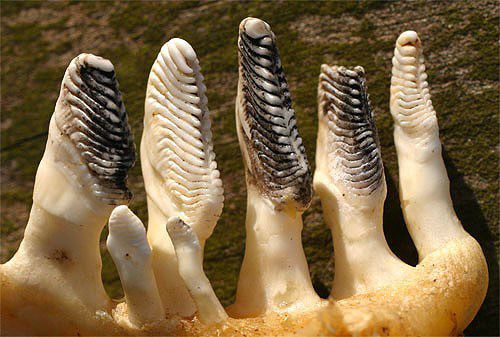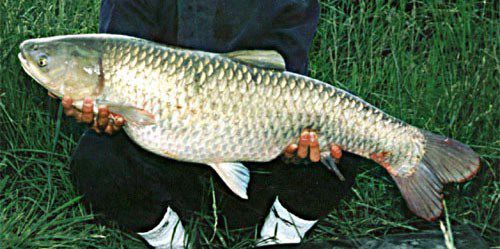|
|
|||
|
|
|||
Back to Preceding Week; on to Next Week
|
EEASC: "CARP DIEM" On 7 March, Hilton Pond Center was honored to host a guided field trip for members of the Environmental Education Association of South Carolina (EEASC), which was holding its annual spring meeting in York County. Many of the state's best, brightest, and most enthusiastic environmental educators are EEASC members, and folks on the field trip exhibited all these qualities--plus a special appreciation for nature in the Piedmont. We were able to teach these teachers lots of interesting things about local phenomena, but thanks to the curiosity of the group we also observed something we'd never seen before at Hilton Pond.  As we started out on the trails around Hilton Pond itself, one vigilant participant noticed a light-colored object glistening in the grass at water's edge. This artifact (above) was near the remains of a Grass Carp that died some weeks before and caught the attention of a couple of fish-eating Black Vultures after it washed ashore. Grass Carp, Ctenopharyngodon idella, are non-native fish originally imported from Asia to eat aquatic plants; they're also called "White Amur" because they occur naturally in the Amur River that forms the border between China and Russia. In about 1990, a neighbor placed ten sterile Grass Carp in Hilton Pond to "improve fishing." The young carp were about ten inches long--big enough to avoid being eaten by Largemouth Bass that also populate the pond--but not too small to devour plants. These little fishes soon went about their business of eating almost every available piece of submerged vegetation, which they used in turn to increase their own body mass to five to seven pounds by the end of the first year, and to 15-20 pounds by year four. Several of these carp eventually died off; by the winter of 2002-2003 only four were left from the original batch but they had grown to prodigious lengths of nearly four feet and individual weights of 30-35 pounds! Swimming slowly about on Hilton Pond with their dorsal and caudal fins breaking the surface, these beasts looked for all the world like sharks trolling the water for their next meal--and could be quite startling when they jerked their tails and propelled away quickly at our approach. Never fear this shark-like appearance, however, because Grass Carp--at least when adult--eat no animal matter, contenting themselves to dine on whatever vegetation might be available. And that brings up the function of the grooves on the teeth we found during the EEASC field trip to Hilton Pond Center. In addition to tooth differences, Grass Carp (below left) are distinguished from Common Carp (below right) and other carp species by their cylindrical body shape, a mouth that opens anteriorly (rather than ventrally), lack of barbels (whiskers) at the edge of the mouth, and the absence of hard, stiff spines in their dorsal and anal fins. The scales of both species are quite noticeable--the size of a 50-cent piece in old specimens.  ........ ........ Images © American Nature Guides: Freshwater Fish by H.W. Robison, 1992 In our estimation, Grass Carp have been a mixed blessing at Hilton Pond Center. At first they did help eliminate submerged plants that interfered with fishing and swimming, but they weren't content to stop there; they kept eating until most vegetation was gone, and--oddly enough--seemed to have left behind only those aquatics that were pernicious and non-native. Instead they ate grasses that would have provided shelter for future generations of baby bass and bluegills or tadpoles and frogs and even dined on surface plants preferred by waterfowl. Fortunately, these underwater behemoths are near the end of their normal lifespans. Most Grass Carp die before 15 years of age and, since they are no longer growing, ours now have appetites that are greatly diminished. With Hilton Pond finally back to its normal depths after four years of drought, we're hopeful the submerged vegetation will rebound, that the balance of aquatic animals will return, and that sometime in the not-to-distant future these last three Grass Carp will succumb to old age, become vulture food, and provide us with several more sets of nicely grooved pharyngeal teeth to share with ever-curious members of the Environmental Education Association of South Carolina. "Carp diem." 
A nearly four-foot, nearly 35-pound Grass Carp All text & photos © Hilton Pond Center NOTE: Be sure to scroll down for an account of all birds banded or recaptured during the week, as well as some other interesting nature notes.
"This Week at Hilton Pond" is written and photographed by Bill Hilton Jr., executive director of Hilton Pond Center for Piedmont Natural History. You may wish to consult our Index of all nature topics covered since February 2000. You can also use the on-line Search Engine at the bottom of this page. For a free, non-fattening, on-line subscription to "This Week at Hilton Pond," just send us an E-mail with Subscribe in the subject line. Please be sure to configure your spam filter to accept E-mails from hiltonpond.org. |
|||
|
Make direct donations on-line through
Network for Good: |
|
|
LIKE TO SHOP ON-LINE?
Donate a portion of your purchase price from 800 top on-line stores via iGive: |
|
|
Use your PayPal account to make direct donations:
|
|
|
Participate in the
Just visit the site for
Operation RubyThroat: The Hummingbird Project by clicking on the link above |
|
SPECIES BANDED THIS WEEK * = New species for 2003
NOTABLE RECAPTURES (with original banding date, sex, and current age) Chipping Sparrow (1) 02/05/02--after 2nd year unknown American Goldfinch (1) 04/23/01--4th year male Northern Cardinal (5) 06/30/01--3rd year male 07/30/01--3rd year female 04/22/02--after 2nd year male 07/20/02--2nd year male 07/29/02--2nd year female House Finch (1) 06/23/01--3rd year male |
WEEKLY BANDING TOTAL YEARLY BANDING TOTAL (2003) 15 species 359 individuals BANDING GRAND TOTAL (since 28 June 1982) 123 species 42,473 individuals SIGHTINGS OF INTEREST --Another 1.2" of rain continued to cause Hilton Pond to pour over the spillway, this week even causing a substantial temporary stream to flow for three days. VAGRANT HUMMINGBIRDS None banded this week. |
|
Up to Top of Page Back to This Week at Hilton Pond Center Current Weather Conditions at Hilton Pond Center |
 post questions for The Piedmont Naturalist |
Join the |
Search Engine for |
|
|